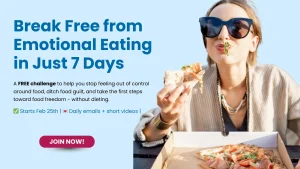You’ve had a long, stressful day. You weren’t planning on eating that chocolate, those chips, or the entire tub of ice cream—but it happened.
And now the guilt sets in.
You wonder:
“Why do I keep doing this?”
“Why can’t I just eat like a ‘normal’ person?”
“Why do I turn to food when I’m not even hungry?”
If any of this feels familiar, you are not alone.
Emotional eating affects millions of people—and for most, it’s not about willpower or discipline. It’s about unprocessed emotions, unmet needs, and outdated coping mechanisms.
But here’s the good news: you can break free.
And it starts with understanding what’s really going on underneath the surface—and getting the right support.
What Is Emotional Eating?
Emotional eating is the act of using food—not to satisfy physical hunger—but to cope with your emotions.
We all do it sometimes. A slice of cake at a birthday celebration. A bowl of soup when we’re feeling sick. That’s normal.
But when food becomes your go-to response for every uncomfortable feeling—stress, loneliness, anxiety, boredom—it becomes a pattern that can sabotage your health, your confidence, and your sense of control.
Emotional eating is not about food.
It’s about how we manage (or avoid) our emotions.
Signs You May Be Struggling with Emotional Eating
-
You eat when you’re not physically hungry
-
Your cravings are sudden and specific (usually for comfort foods like sweets or carbs)
-
You eat quickly and mindlessly, often standing or in front of a screen
-
You feel guilty or ashamed after eating
-
You feel like food controls you
-
You eat to “numb out” or avoid difficult thoughts or feelings
-
You often eat in secret
If you nodded at several of those, you’re not broken. You’ve just learned to use food as a way to feel better. The problem is—it doesn’t really fix the feeling.
Why Food Feels Like a Solution
Let’s get one thing clear: food is soothing.
It lights up pleasure centres in the brain. It’s associated with love, comfort, and safety. When you’re overwhelmed or emotionally raw, eating can feel like the only thing that helps.
But here’s the problem:
Food offers temporary relief.
It doesn’t resolve the cause of the emotion—it just numbs the symptom.
Once the taste fades, the original emotion is still there—now with an added layer of guilt, shame, and discomfort.
The Emotional Roots of Emotional Eating
There’s no one-size-fits-all reason for emotional eating. But there are common emotional triggers:
1. Stress
High levels of stress trigger cortisol, which increases appetite—especially for sugar and fat.
2. Loneliness
When we crave connection but don’t have it, food fills that void—momentarily.
3. Boredom
Eating becomes an activity, a distraction from stillness or lack of stimulation.
4. Sadness or Grief
We turn to food to soothe sadness, but the comfort is short-lived.
5. Anxiety
The chaos in our minds makes food feel like a grounding force—one we can control.
But no matter the reason, emotional eating becomes a coping mechanism. A learned behaviour. And like all behaviours—it can be unlearned and replaced.
What Emotional Eating Is NOT
-
It’s not a lack of discipline
-
It’s not a moral failure
-
It’s not something to be fixed with a strict diet or food rules
In fact, restrictive diets often make emotional eating worse, because they trigger feelings of deprivation—which eventually lead to overeating.
If you’ve tried diet after diet, only to “fall off the wagon” and binge again, you’re stuck in the restrict–binge–guilt cycle.
It’s not your fault.
It’s the system you’re in.
So How Do You Break the Cycle?
You don’t break emotional eating by obsessing over food.
You break it by:
-
Learning to tune into your body
-
Rebuilding trust with your hunger and fullness cues
-
Learning emotional awareness and regulation
-
Practicing self-compassion, not punishment
-
Creating a toolbox of non-food coping strategies
That’s where the 7 Days to Food Freedom Challenge comes in.
Introducing: The 7 Days to Food Freedom Challenge
A simple, powerful journey to help you:
-
Understand your emotional eating triggers
-
Learn practical tools to pause before reaching for food
-
Build trust with your body
-
Feel more in control—without restriction or guilt
-
Begin healing your relationship with food
💛 What’s Included:
-
7 short, daily videos (5–10 minutes each) to guide your mindset and habits
-
Simple daily exercises to help you practice what you learn
-
Supportive journaling prompts to deepen your self-awareness
-
A bonus audio track to help calm cravings and self-soothe
-
Encouraging emails to keep you motivated and supported
Whether you’re just starting this journey or have been struggling for years, this challenge is designed to meet you where you are.
And the best part? It’s free.

What You’ll Learn in 7 Days
Each day of the challenge focuses on a different core skill that helps break the cycle of emotional eating.
✅ Day 1: The Truth About Emotional Eating
Get clarity on what emotional eating really is—and why diets don’t work.
✅ Day 2: Pause and Check-In
Learn a simple technique to pause before you eat and ask what you really need.
✅ Day 3: Feelings vs. Hunger
Understand the difference between emotional and physical hunger—and how to respond to each.
✅ Day 4: Building Your Emotional Toolbox
Explore powerful non-food tools to soothe your feelings.
✅ Day 5: Reconnecting with Your Body
Practice mindful eating and self-trust around food.
✅ Day 6: Self-Compassion Instead of Shame
Learn to talk to yourself with kindness—even when you “mess up.”
✅ Day 7: Your Food Freedom Plan
Create a simple, realistic plan to keep moving forward—without perfection.
Why This Challenge Works
Unlike diets or rigid food plans, the 7 Days to Food Freedom Challenge doesn’t ask you to give anything up.
Instead, it helps you:
-
Understand what’s really driving your cravings
-
Feel safe with your emotions
-
Let go of guilt and food rules
-
Take small, sustainable steps toward peace with food
Most importantly, it helps you feel seen, supported, and empowered.
Because emotional eating isn’t about food—it’s about how you feel. And healing starts when you feel safe enough to be curious, not critical.
What Participants Are Saying
“This challenge was a total mindset shift. I’ve stopped judging myself for eating and started understanding my patterns. I feel hopeful again.” – Sarah
“The daily videos are short but powerful. For the first time in years, I feel like I’m not broken, I just needed support and the right tools.” – Jenny
“I’ve done every diet out there. This was the first thing that helped me understand myself. No pressure. No shame. Just support.” – Melissa
Your Struggle Doesn’t Define You
You are not your eating habits.
You are not your cravings.
You are not your “failures.”
You are someone who has tried to feel better—and did the best you could with what you had.
Now, it’s time to try something new.
Final Thoughts: You Don’t Have to Keep Struggling
If you’ve been stuck in the cycle of emotional eating, you may feel hopeless, ashamed, or exhausted.
But the truth is: you can change. And you don’t need another diet to do it.
You need:
-
Understanding
-
Awareness
-
Kindness
-
Support
That’s what the 7 Days to Food Freedom Challenge is here to offer you.
It’s not a quick fix. It’s the beginning of a deeper shift—a shift toward peace, freedom, and self-trust.
💛 Ready to Start?
Join the 7 Days to Food Freedom Challenge now.
It’s free, it’s supportive, and it just might be the turning point you’ve been looking for.
Because you deserve a life where food isn’t the enemy.
Where you can feel your feelings—and feed your body with care, not fear.
Your journey to food freedom starts with one small step.
Take it today. 💛
